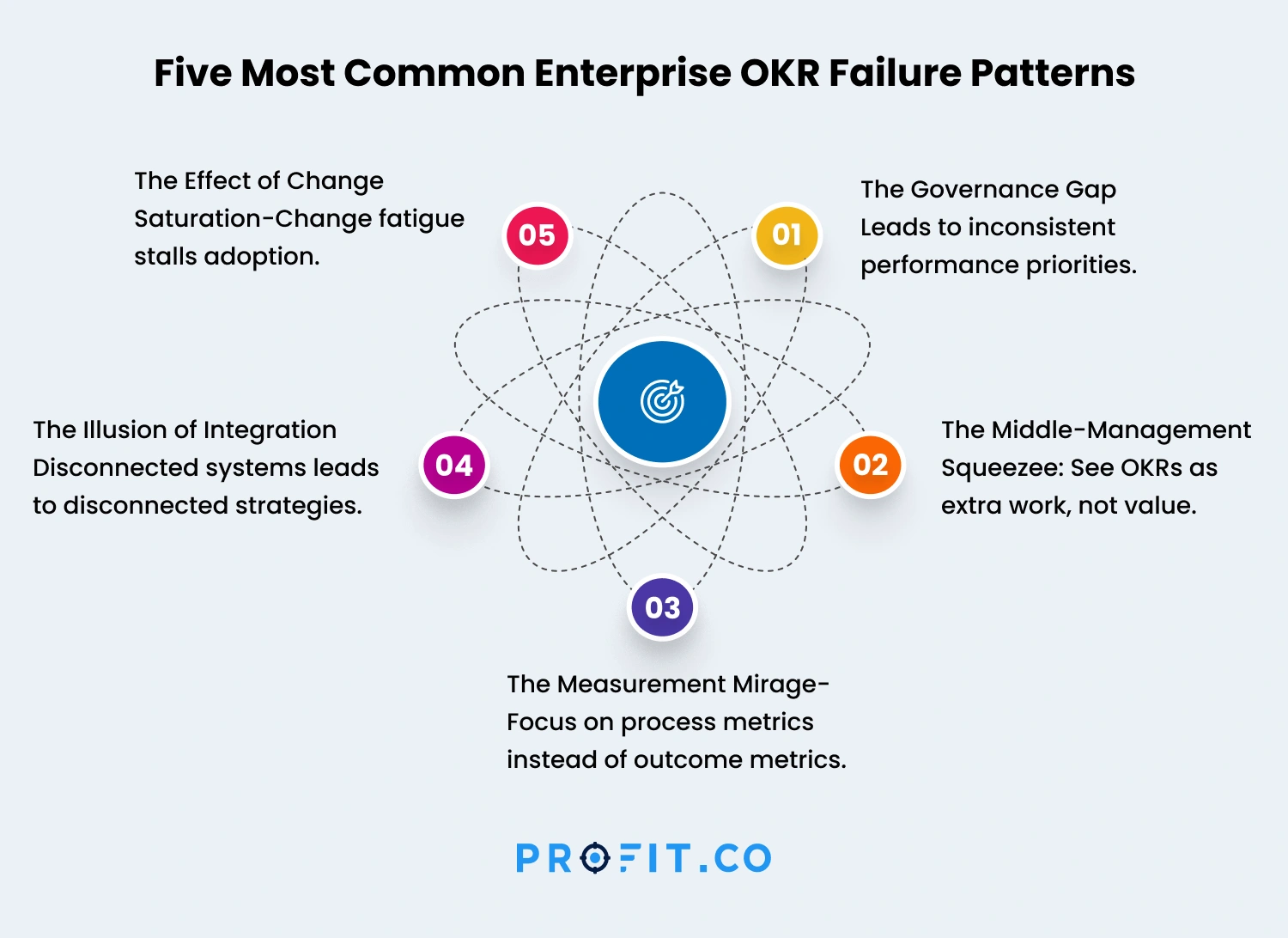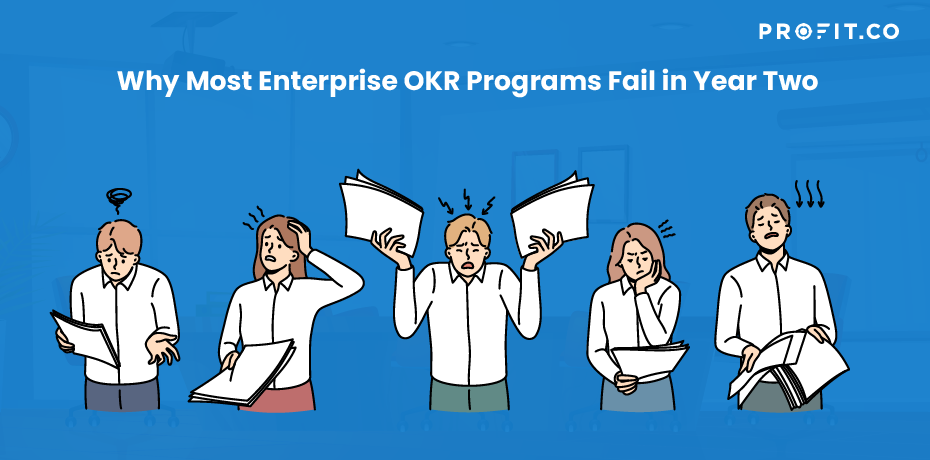Who did it? What leadership called “initiative fatigue,” but what was really a failure pattern that happens in three out of four enterprise OKR implementations.
This isn’t the only time this has happened. Our examination of many enterprise OKR programs initiated reveals a concerning trend: although the majority of programs exhibit initial enthusiasm and adoption in their inaugural year, almost more than half are either considerably reduced or completely discontinued by the second year. For companies that spend $2–5 million on these changes, this is more than just money that has been wasted; it has also lost strategic momentum and trust in systematic goal management.
The question isn’t if OKRs work on a large scale. For decades, companies like Google, Intel, and Adobe have shown that they work. The question is why so many programs with good intentions and lots of money don’t make it past their second year. What makes those that do make it past their second year different from the rest?
TL;DR:
Most enterprise OKR programs thrive in their first year but collapse in their second due to predictable patterns—governance gaps, middle management resistance, measurement obsession, poor system integration, and change fatigue. The 27% that succeed approach OKRs as a system design challenge, not a software rollout. They invest early in governance infrastructure, align decision rights, integrate OKRs into existing planning systems, and track leading indicators of strategic health rather than process compliance.What is The Myth of Linear Growth
The first and most dangerous thing that business leaders think is that OKRs grow in a straight line. The idea is that if OKRs work for a startup with 50 employees, they should work for a company with 50,000 employees as well; you just need better software and more training.This assumption doesn’t take into account how much more complicated things get in big companies. Think about the math: a startup with 50 employees and three levels of management might have to keep track of 15 different goal relationships. An organization with 50,000 employees and 8 levels of management has more than 400 unique relationship patterns, each with its own needs for communication, rights to make decisions, and ways to measure success.
What are the three ways that the Linear Scaling Fallacy shows up:
1. Communication Complexity Explosion
In small businesses, people get on the same page by talking to each other informally and having all-hands meetings. Enterprise leaders often don’t realize that going from 50 to 5,000 people doesn’t just mean 100 times more communication; it also means completely different ways of communicating. What happened? As it moves through different levels of the organization, the goal context gets lost in translation.2. One-Size-Fits-All Processes
Startups can use the same OKR rhythm and review process for all of their projects. Different parts of a business need to work at different speeds. For example, product teams should work in quarterly cycles, compliance teams should work in annual cycles, and sales teams should work in monthly cycles. When companies make all their departments use the same processes, they cause friction that eventually leads to people leaving.Technology as a Silver Bullet
Startups can use spreadsheets or simple tools to manage OKRs, but big companies often spend a lot of money on advanced OKR platforms before they deal with basic process and culture issues. Technology can’t fix problems with alignment that come from a lack of clear strategy or bad organizational design
What are Five Most Important Enterprise OKR Programs Failure Patterns?
Our study found five different patterns that can lead to the failure of an OKR program in a business setting. It’s important to know these patterns because they often happen at the same time, causing a chain reaction that can break even the best-laid plans.1. The Governance Gap is the first pattern.
This is what it looks like. After six months in the program, different parts of the business are following the OKR rules in different ways. Engineering sets three goals every quarter, while marketing sets twelve. Sales ties OKRs to pay for each person, but HR says this is not allowed. Finance wants updates every month, but Product works on cycles of three months.Why does this happen? Companies don’t realize how much governance infrastructure they need to keep different business functions consistent. In contrast to startups, where the founder can make decisions about changes to processes in real time, businesses need documented decision rights, escalation paths, and change management processes.
What is the hidden cost? When different parts of the organization have different ideas about what the OKRs mean, the program loses its main benefit, which is to bring everyone in the organization together. Teams work to meet their own goals instead of the company’s goals, which leads to competition instead of cooperation.
2. The Squeeze on Middle Management.
What it looks like: Senior executives support the program and individual contributors work toward their own goals, but middle management becomes more and more opposed. They complain about “administrative overhead” and start using OKRs as a way to make sure everyone is following the rules instead of as a way to plan.Why does it happen? Middle managers have the most work to do in enterprise OKR programs. They must turn strategic goals from above into tactical goals below, help different departments work together, and coach their teams, all while keeping up with their current duties. Middle managers see OKRs as extra work that doesn’t seem to help them personally, while senior executives see strategic benefits and individual contributors focus on specific tasks.
The hidden cost of this situation: Resistance from middle management makes it hard to translate strategy into action, which breaks the link between the two. When middle managers don’t really get involved in the program, they can’t give their teams the context and coaching they need to set meaningful goals or understand how their work fits in with the company’s goals.
“We don’t have to be smarter than the rest . We have to be more disciplined that the rest.”
3. The Measurement Mirage
What it looks like in an Organization: The company gets so focused on OKR completion rates, scoring accuracy, and update frequency that it forgets to check if OKRs are actually helping the business do better. Dashboards say that most teams have updated their OKRs, but employee engagement scores go down and strategic initiatives still don’t meet their goals.Why it happens: Businesses have advanced ways to measure things, which makes them feel like they have to measure everything about the OKR program instead of just whether it’s getting the results it was meant to. Tracking process metrics (like completion rates, scores, and update frequency) is easier than tracking outcome metrics (like the quality of decisions, how well they align with the strategy, and how well resources are used).
The hidden cost: When companies focus on process metrics instead of outcome metrics, they add unnecessary layers of bureaucracy that make it hard to see the program’s real effects. People think that OKRs are “busy work” because teams spend more time keeping them up to date than using them to make decisions.
4. The Illusion of Integration
What it looks like: OKRs are a separate system that works with existing planning processes, performance management systems, and project management tools. Teams keep their OKRs in one place, their project tracking in another, their performance reviews in a third, and their strategic planning in a fourth. Each system needs different timelines, formats, and ways to measure success.Why it happens: Businesses have put a lot of money into their current systems and processes. Instead of redesigning these systems to include OKRs, companies often just add OKRs on top of them, which creates multiple sources of truth and makes employees keep the same information in different formats.
The hidden cost: When OKRs aren’t linked to the systems that people already use to do their jobs, they don’t work as well. Employees have to deal with cognitive overload when they have to keep track of more than one planning system, and leaders lose faith in OKRs because they don’t show the true state of important projects.
5. The Effect of Change Saturation
The OKR program starts when or soon after other big changes happen in the organization, like digital transformations, restructures, system implementations, or cultural initiatives. At first, employees are excited about the changes, but then they start to feel “change fatigue” as they try to learn new ways to manage their goals while also meeting other transformation needs.Why it happens: Businesses are always changing, and leaders often see OKR implementation as a way to support other changes rather than as a way to compete for the same capacity for organizational change. But every change project needs the same group of employees to pay attention, learn, and change their behavior.
The hidden cost: When OKR programs compete with other changes for attention in an organization, they are often pushed to the back burner because they are seen as “process improvements” instead of “business critical” changes. This leads to incomplete adoption and eventual abandonment when more important projects take priority.
The Anatomy of Year Two Enterprise OKR Programs Collapse
The change from year one to year two is a very important turning point for enterprise OKR programs. Year one is marked by excitement, trying new things, and being okay with things not being perfect. In year two, you need to follow a plan, stick to your processes, and get results that can be measured. This change reveals basic flaws that were hidden by the initial momentum.The Year One Honeymoon Effect Most business OKR programs do well at first because they get:
- Attention and support from executives
- The novelty effect makes people more interested.
- Being open to learning and trying new things
- Instead of focusing on getting results, focus on adopting the process.
- Dedicated resources for program management
The Year Two Reality Check Year two brings new problems:
- When there are too many things to do, executives don’t pay as much attention
- The newness wears off, and the process starts to show friction.
- The demand for measurable business impact rises
- People who work in program management often get moved around.
- System integration problems become very important

What Organizations That Succeed with Enterprise OKR Programs Do Differently
Our study of enterprise OKR programs that do well after the second year shows four major differences in how they implement them:1. They Start with Organizational Design, Not Goal Setting
Before starting OKR processes, successful programs first map out decision rights, information flows, and accountability structures. They want to know, “How do decisions really get made in our organization?” and “Where do our current planning processes create alignment or friction?” Only after they understand how the organization works do they create OKR processes that work with, not against, the ones that are already in place.For example, a global tech company spent the first six months of the year finding 23 different planning processes in their business and figuring out how they worked (or didn’t work) with strategic execution. Instead of adding a 24th planning process, they made their OKR program to strengthen and improve these connections.
2. They set up governance systems before they scale
Instead of spreading OKRs widely and dealing with governance issues as they come up, successful programs set up clear governance structures first. This includes who can change OKRs and when, how to settle disagreements between competing goals, and how to change the program based on what you learn.Before starting their program, a financial services company set up an “OKR Council” with one person from each major business unit. The council’s job was to settle disagreements about how things should be done, approve changes to the process, and make sure that different parts of the business were all doing things the same way. This stopped the governance gaps that usually happen between months 6 and 12.
3. They look at both leading and lagging indicators.
Most programs only look at completion rates and scoring accuracy, but successful programs look for and keep track of leading indicators of program health, such as improvements in decision quality, increases in cross-functional collaboration, higher success rates for strategic initiatives, and managers’ confidence in the goal-setting process.For example, a manufacturing company measured “strategic decision speed,” which is the time it takes to find a strategic issue and come up with a solution, before and after they used OKRs. They discovered that OKR programs sped up decision-making significantly even when traditional metrics like scores and completion rates looked average.
4. They Design for Diversity, Not Uniformity
Successful enterprise programs know that different business functions need different OKR approaches, but they all need to be in line with each other. They set up common rules and measures while still letting processes change to meet the needs of different functions.For example, a healthcare company used quarterly OKRs for product development, annual OKRs for following the rules, and monthly OKRs for sales. They maintained alignment through the use of common reporting formats and shared strategic themes.
The Path Ahead: : A Different Approach
It’s clear that traditional methods for implementing enterprise OKRs don’t work most of the time. This isn’t because OKRs don’t work when there are a lot of them; it’s because most companies think of scaling as a simple math problem instead of a complicated systems problem.The effective strategy necessitates:
- Instead of asking, “How do we implement OKRs?” successful organizations ask, “How do we improve our goal management system?” This change in perspective leads to solutions that work with what the organization already has instead of against it.
- First, governance; second, technology. Technology is important, but governance infrastructure is even more important for long-term success. Before they need advanced tracking tools, businesses need to have clear decision rights, escalation paths, and change management processes.
- Instead of looking at OKR completion rates, successful programs look at whether OKRs make decisions better, resources are used better, and strategies are carried out better. Program managers can use process metrics, but outcome metrics are what keep a program going.
- Successful enterprise programs keep strategic alignment while allowing for functional diversity. They set common rules and metrics, but they also let processes change to fit different business situations.
Your Next Steps: The Enterprise OKR Review
If you’re in charge of or thinking about starting an enterprise OKR program, the first step to success is to honestly evaluate how ready and capable your organization is right now. The organizations that don’t fail all have one thing in common: they take the time to learn about their organizational context before putting OKR processes into place.Think about these important questions:
1. Readiness for Governance
- Do you know who has the power to make decisions when there are conflicts between goals across departments?
- Can you tell who has the power to change strategic goals and when?
- Do you have set ways to handle disagreements over alignment?
2. Ability to integrate
- How many different ways does your organization plan things right now?
- What systems and processes do you already have that need to work with your OKR program?
- What would it take to make your planning easier instead of adding to it?
3. Change Capacity
- What other big changes is your company working on right now?
- Do you have people who are in charge of managing change for OKR implementation?
- How will you keep the momentum going when executives start to focus on other things?
4. The Philosophy of Measurement
- How will you know if your OKR program is making things better for the business?
- What early signs will show that a program is likely to be successful before later signs do?
- Do you have baseline data on decision quality, alignment, and strategy execution?
It’s not by chance that business OKR programs work. They are successful because they know that managing goals on a large scale needs more than just training and technology; it needs systems thinking, governance infrastructure, and integration capabilities.
You can join successful organizations, but only if you see OKR implementation as a complex systems challenge instead of a simple process rollout
Are you ready to see how prepared your company is for OKRs?
Because things are getting more complicated faster than they can be designed, there is no clear governance, integration with existing processes is weak, and competing change initiatives take up time and energy. This makes OKRs feel like “extra work” instead of how work gets done.
The governance gap, the middle-management squeeze, the measurement mirage, the integration illusion, and the change saturation. These often stack on top of each other, which can lead to failure.
Use leading indicators like how quickly decisions are made, how much work is done across departments, how many initiatives are linked to strategy, how confident managers are in setting goals, and how quickly resources are moved around.
No. Use different cadences (like quarterly for product, yearly for compliance, and monthly for sales) while still following the same rules and reporting.
First, there are decision rights, escalation paths, change control, and standards for how to interpret things. Then add technology to make things bigger, not to make up for them
Provide managers real benefits, like fewer meetings thanks to structured check-ins, cross-team escalation paths that really solve problems, and coaching playbooks that are linked to their KPIs.
Make a map of your planning, performance, and project stack. Use OKRs as the backbone that connects strategy, portfolio, initiatives, and metrics. One source of truth; everyone agrees on what things mean.
Governance was defined, an integration map was made, the change bandwidth was confirmed, baseline metrics were collected, and a cross-BU OKR council was chosen.
Related Articles
-
How to Cascade OKRs Across Departments
TL;DR Cascading OKRs is the method of carrying company-level objectives down through departments, teams, and individuals, where each level adopts... Read more
-
How to Align OKRs Across a Large Enterprise Without Losing Momentum
TL;DR Most enterprises lose strategic momentum from misaligned goals. This guide shows you how to create clear OKR alignment using... Read more
-
How Should Enterprises Redesign OKRs for Better Execution at Scale?
A lot of companies try to use startup-style OKRs, only to find they fall flat as the business grows. This... Read more
-
OKR 101: 38 Most Common OKR Questions Answered
OKRs (Objectives and Key Results) are one of the most powerful ways to connect strategy with execution. Whether you're a... Read more




